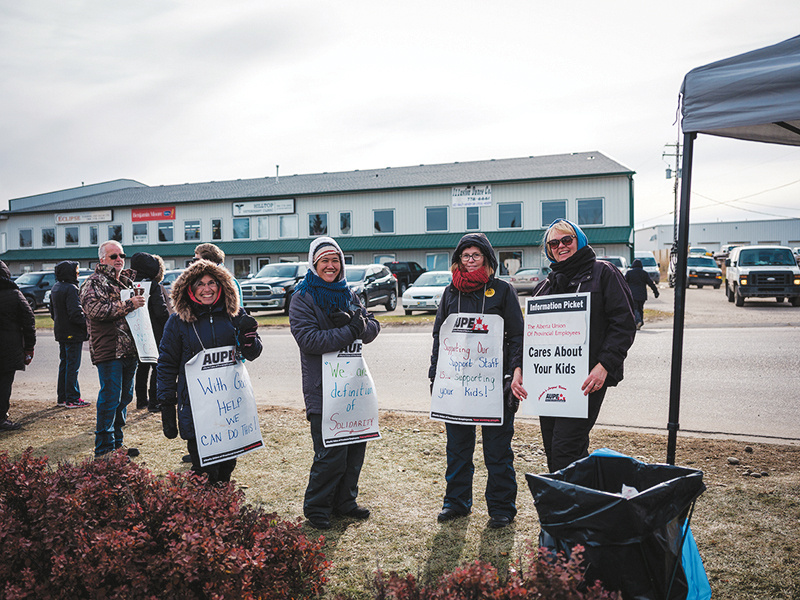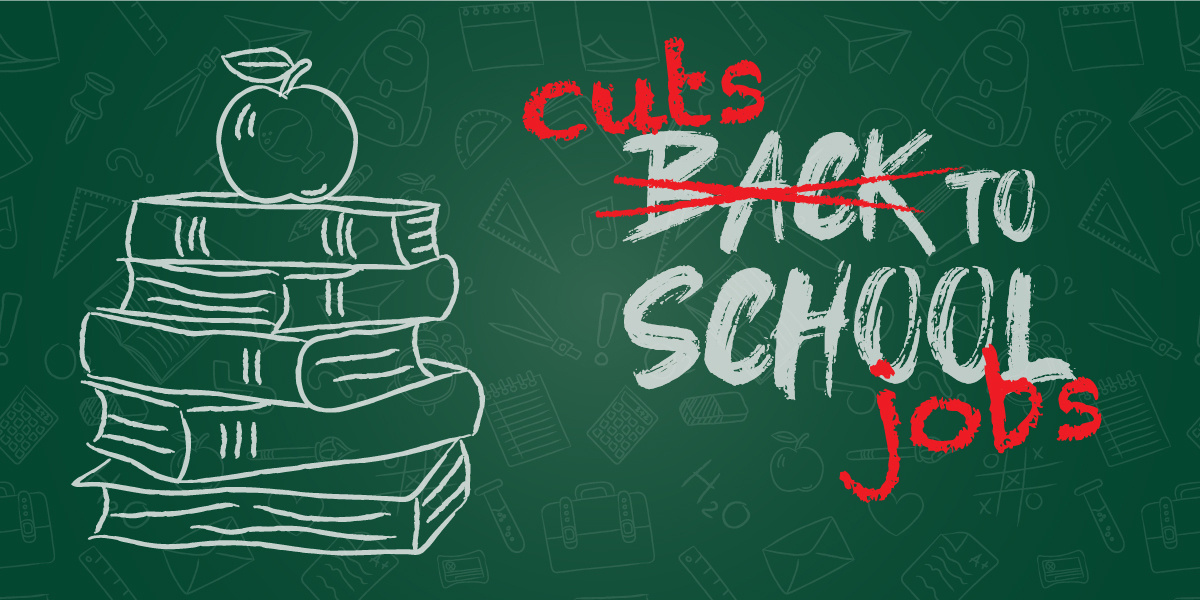Children pay the price for callous cut to 25,000 school jobs
Kids with special needs felt it the most.
Jul 28, 2020
by Terry Inigo-Jones, Communications staff
Jason, an autistic Grade 7 pupil, starts every school day saying he’s going to have a bad day.
Every day, his educational assistant (EA) Candace Halvorson, makes sure that doesn’t happen.
“He always tells me he’s going to have a bad day and yet, he has a good day,” says, Halvorson, a junior-high support EA at Whitecourt’s École St. Joseph and chair of AUPE’s Chapter 012, Local 071.
She is one of 80 support staff workers employed by the Living Waters Catholic Separate School Division, which serves the communities of Whitecourt, Edson and Slave Lake, who lost their jobs with the surprise weekend announcement on March 28.
The scale of the cuts is staggering: About 25,000 jobs were axed in K-12 schools.
The way it was done is shocking: On Twitter, on a weekend and without any advance notice to school boards or workers.
The economic effect on families is devastating: Losing more jobs during a tsunami of unemployment is hard, especially for those families have already lost an income.
However, the real cost is being paid by those least able to bear it, the children, particularly those with special needs, who are having vital supports taken away from them when they need them most.
“I wish one of them would have had a child with special needs, because then they would understood the importance of the educational assistant,” says Halvorson.
She’s been an EA with the Living Waters Catholic Separate School Division for 12 years, helping Grade 7 students with core subjects, as well as helping English Language Learners (ELL) in Grade 10 science.
She fears most of her laid off co-workers, including herself, won’t be rehired, even when school starts again in September, with school boards under pressure from the Alberta government to rein in spending.
“Our school believes that every student in the building should have a person,” she’s says proudly. “So, I am Jason’s person, and I think of what’s going to happen when he comes back to school and I’m not there to greet him.”
What will happen if no one is there to help him turn a bad day into a good day.

Parents hurt and angry
Halvorson says the parents she has talked to “are outraged and they are hurt and angry. And they are afraid. What’s going to happen to their child?”
As well as EAs, the Living Waters cuts also include custodians and facilitators. These AUPE members play a crucial role in supporting the kids, especially during the pandemic.
Zenovia Crawford is a Living Waters parent. She has four children – two daughters, who have already passed through the school system, and two boys who are still in it.
Cutting the jobs of custodial workers made no sense, she says, especially during a pandemic when cleaning is even more important. Everything in the schools needs to be sanitized more now, not less, says Crawford, who used to work as a custodian for Living Waters.
“Why do you think they worked all summer? Because they have to wash all the walls in every single room, all the floors in every single room, strip the floors, rewax the floors, turn the desks inside out and actually wash the interiors of the desks and the bottoms of the desks and the bottoms of the chairs, scrape off all the gum.”
While none of her children have specialized learning needs, she feels for families that do have children who need help, especially now.
These children are having to try to adapt to remote learning without the help of their trusted EAs, who otherwise could have reached out to them through the internet or on the phone.
“Now these kids are having to do all this stuff independently and it’s just jacking up their stress level that much more. They are going to fall behind,” she says.

Jobs cuts already affecting children
When Calvorson first heard the news about the job cuts, her first thoughts, weren’t for herself. They were for “my boys,” as she calls them.
“I have been with this group of boys on and off for the last five years, so I have great working relationship with them and their families.”
Students are often closer with an EA than with a teacher, because the EAs are a constant figure over a number of years, whereas teachers usually change every year. They become like family. Severing that relationship is “devastating,” Halvorson says.
The students are not reacting well to the loss of their EAs, she says.
Whether working in the classroom in normal times, or doing online or distance learning, EAs were a vital support.
“I don’t want any kid to fall through the cracks… We make sure that that student does not get left out or does not feel neglected or feel like they’re not contributing to the whole community of the school. Educational assistants are the only way to do that,” says Halvorson.
“My group of boys sometimes get very frustrated because they don’t feel like they are academically capable of doing things. Removing them from a classroom, sometimes is the only thing that they need to do so that they have a quiet work environment.
“That’s what I do. I know my boys well enough to know: ‘Oh, you need a walk. Or: ‘Oh, you’re done, you need to have something to eat.’ I provide snacks. I provide breaks,” she says. “Just because you can’t sit in your desk doesn’t mean that you can’t learn.”
“I provide the belief for them that they are capable of doing absolutely everything.”
Children need more support during the pandemic, not less
With distance learning, which replaced in-person classroom learning at the onset of the COVID-19 crisis, EA support becomes even more important.
Many children are already stressed by the sudden and massive change in how schools are operating. They’re having to negotiate that change and rely on technology without the support of the EAs on whom they have come to depend.
“One of the boys, as an example, has an extreme form of dyslexia and doing the novel study, I could have read the chapter to him, and we could have worked on the questions together (online),” says Halvorson.
“Now, he’ll have to do that independently or his Mom (will have to help). He’s very lucky. He has supportive parents and I know that. But I could have been reading The Outsiders novel with him and working on questions with him through the online learning, so that his reading challenge was still being met.”
That distance-learning support could have been achieved at a modest cost. Workers had a Letter of Understanding that allowed the employer to cut them to part-time work on reduced pay. “Of course, that letter of understanding went out the door as soon as they laid us off.”

UCP veil is thin
The government’s excuse that it needed to make these cuts to save money for the COVID-19 fight bears little weight with Halvorson or Crawford.
The government claimed these job cuts would save $128 million, money it couldn’t afford to spend because of the economic collapse and the cost of the pandemic.
A few days after announcing the cuts, however, the Alberta government found $1.5 billion to fund a private corporation’s pipeline project. It gave that money, along with a loan guarantee of $6 billion more, to TC Energy Corporation for its controversial Keystone XL pipeline project.
That investment is starting to look shaky, with U.S. Democratic Presidential candidate Joe Biden saying he’ll kill the Keystone project if elected later this year.
Even if it survives, the Alberta government said it would create fewer than 6,000 direct and indirect Alberta jobs. Critics have said some of the jobs created would be in the U.S., not Alberta.
Crawford said: “I believe that we need to protect our oilfield, but we don’t need to protect our oilfield on the backs of our children by taking away their educators.”
Halvorson, whose husband works in the oil-and-gas industry, was livid.
“Oh, I was mad. I was furious.” She says it’s “unimaginable” that anyone would place a pipeline above the needs of children.”